[Answered] What is Claim Adjudication?
Billing isn’t as simple as submitting a claim to a patient’s insurance payer, the payer reviewing the document, and you get paid. If you aren’t a seasoned medical biller, you are probably asking yourself, “what is claim adjudication?” Let's find out.

30% of insurance claims get denied on their first submission. Part of this is because of the complicated nature of the claim adjudication process.
There’s nothing simple about the claim submission process. Any medical biller with some experience will agree that there are a lot of steps.
Billing isn’t as simple as submitting a claim to a patient’s insurance payer, the payer reviewing the document, and you gett paid.
Every claim you submit goes through an adjudication process, regardless of which insurance company it gets submitted to.
If you aren’t a seasoned medical biller, you are probably asking yourself, “what is claim adjudication?” Let's find out.
What is a claim?
According to Healthcare.gov, a claim is a request for payment that a healthcare provider submits to a health insurer for items and services potentially covered by the insurer.
If that sounds confusing, let me break it down further.
A medical claim is a document. Healthcare organizations use these documents for reimbursement from insurance companies (aka payers).
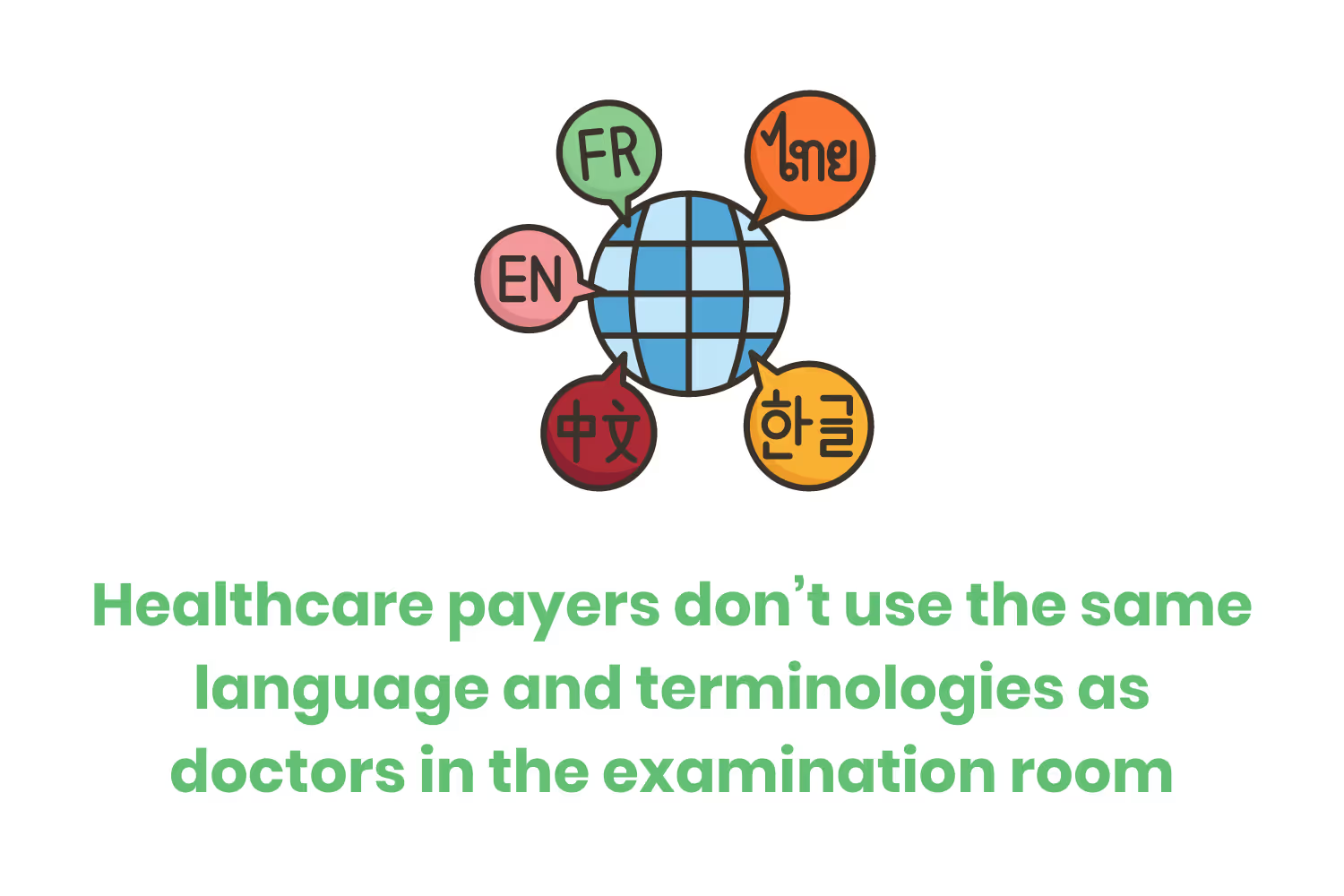
Here’s the kicker: healthcare insurance companies don’t use the same language and terminologies as doctors in the examination room. Therefore, healthcare providers need to use sequences of numbers and letters to “code” the diagnosis and services rendered.
Medical claims have charges and codes to standardize services for faster payer approval and reimbursement. These codes are Current Procedural Terminology (CPT) codes that describe the medical services provided to patients including...
- Procedures
- Exams
- Diagnoses
- Coded using ICD-10 codes
- Prescriptions
- Medical supplies
- Transportation
- Devices

Now a new question arises: what’s in this claim document?
A medical claim includes a header and details section. These sections combined help describe the patient’s medical history and treatment.
The claim header has six unique sections. First, the claim has the patient’s basic information, including their legal name, date of birth, current address, and gender. Second is a section for the National Provider Identifier (NPI). This number is equivalent to the healthcare provider’s Social Security Number.
Next comes all of the CPT codes related to the primary services provided. The payer’s name, the healthcare provider’s charges, and any inpatient procedure details conclude the claim’s header section.
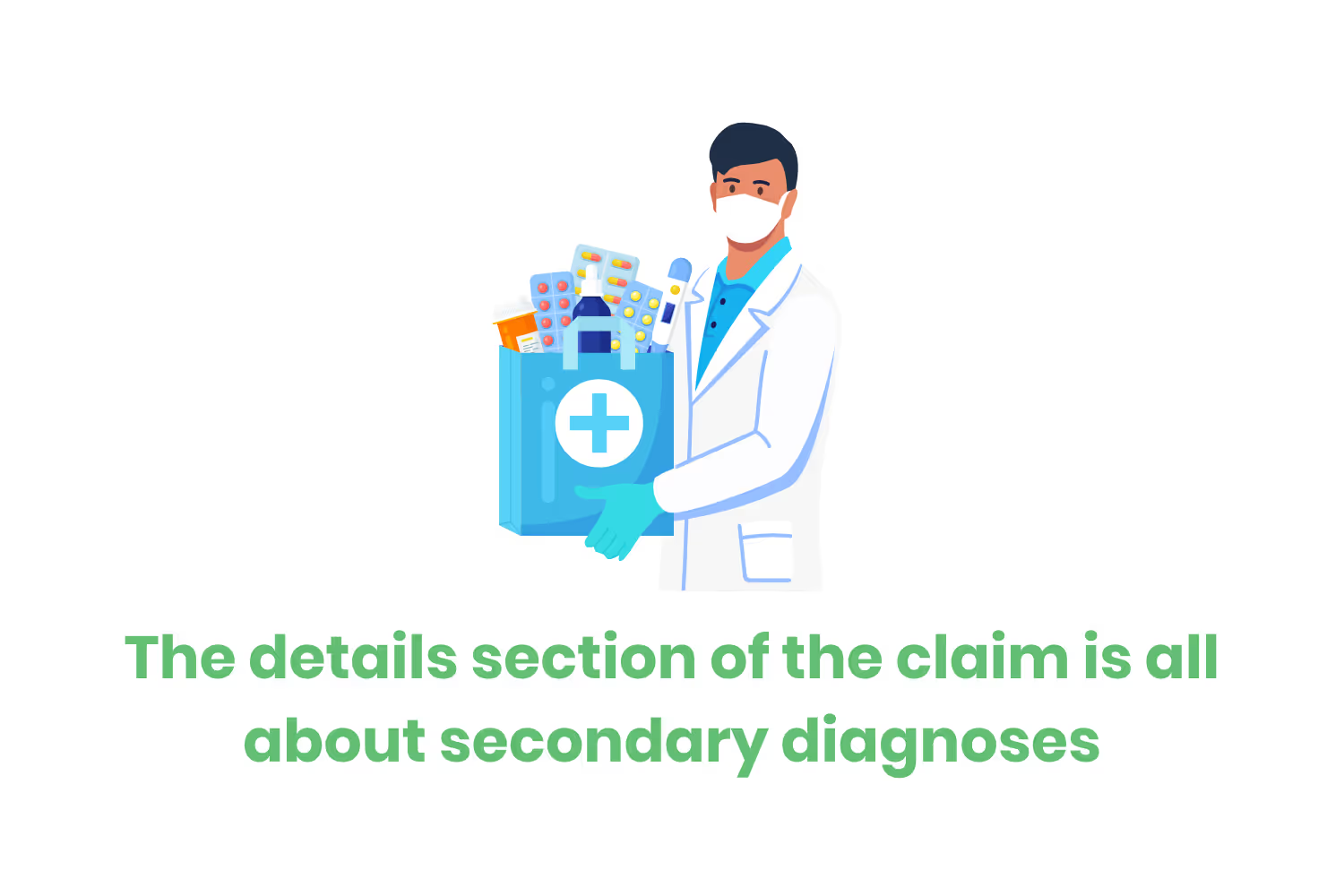
The details section of the claim is all about secondary diagnoses. These types of diagnoses come about as your treat the primary diagnosis listed in the header. However, unlike a primary diagnosis, secondary diagnoses require less attention and fewer services.
Secondary diagnoses have five items: date of service, CPT codes, Diagnosis Related Groups (DRGs), the practice’s NPI, and the charges. National Drug Codes (NDCs) also go into the details of the claim if the healthcare provider prescribed something to the patient.
What does "adjudication" mean?
Unfortunately, adjudication is a legal term. This means that on any other day, you would need to search for the definition on Google and try to make sense of lawyer jargon. However, you clicked on this blog and I’ll break it down for you!
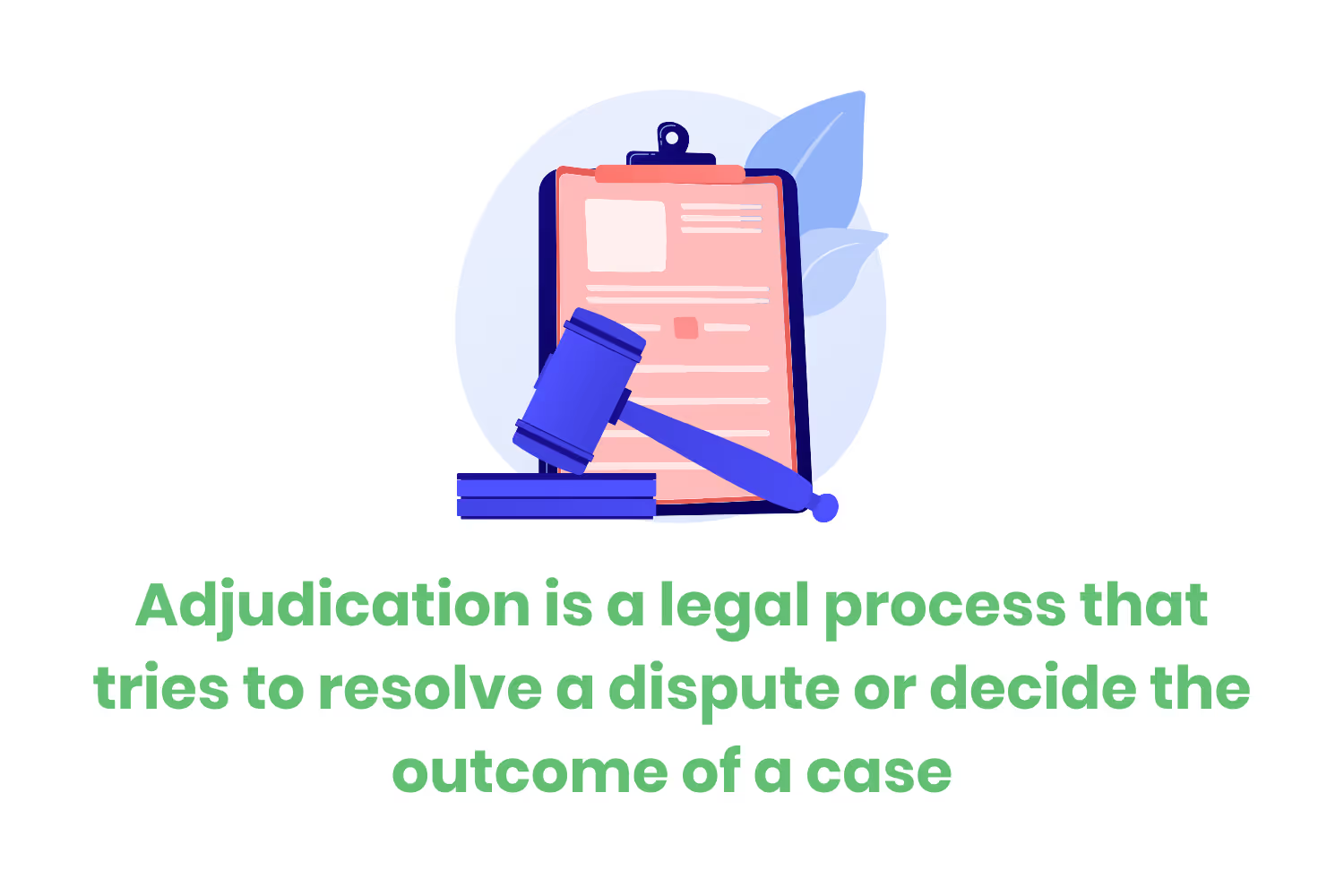
Adjudication is a legal process that tries to resolve a dispute or decide the outcome of a case. When people take a disagreement or accusation to court, the courts process all the information provided to analyze the situation. Using the law, the courts will decide what right and wrong actions took place during the relevant incident(s).
When there’s enough friction and controversy in the case to warrant judicial intervention, the case becomes “ripe for adjudication”. A case doesn’t need adjudication when it pertains to hypothetical questions or possibilities. This is because The constitution only allows courts to preside over actual cases and controversies.
Adjudication has a second legal definition of the actual judicial decision. A “doctrine of former adjudication” helps determine the effects of a judgment. When this happens, a final judgment in a prior court proceeding prevents the re-litigation of any issues relevant to the ruling.
What is claim adjudication?
At this point, you should have a basic understanding of medical claims and the legal definition of adjudication…but you’re likely still wondering how this all pertains in the healthcare space.
According to Law Insider, claim adjudication is a process that insurance payers go through to determine how much they owe the provider. They use the claim sent from the healthcare provider to decide.
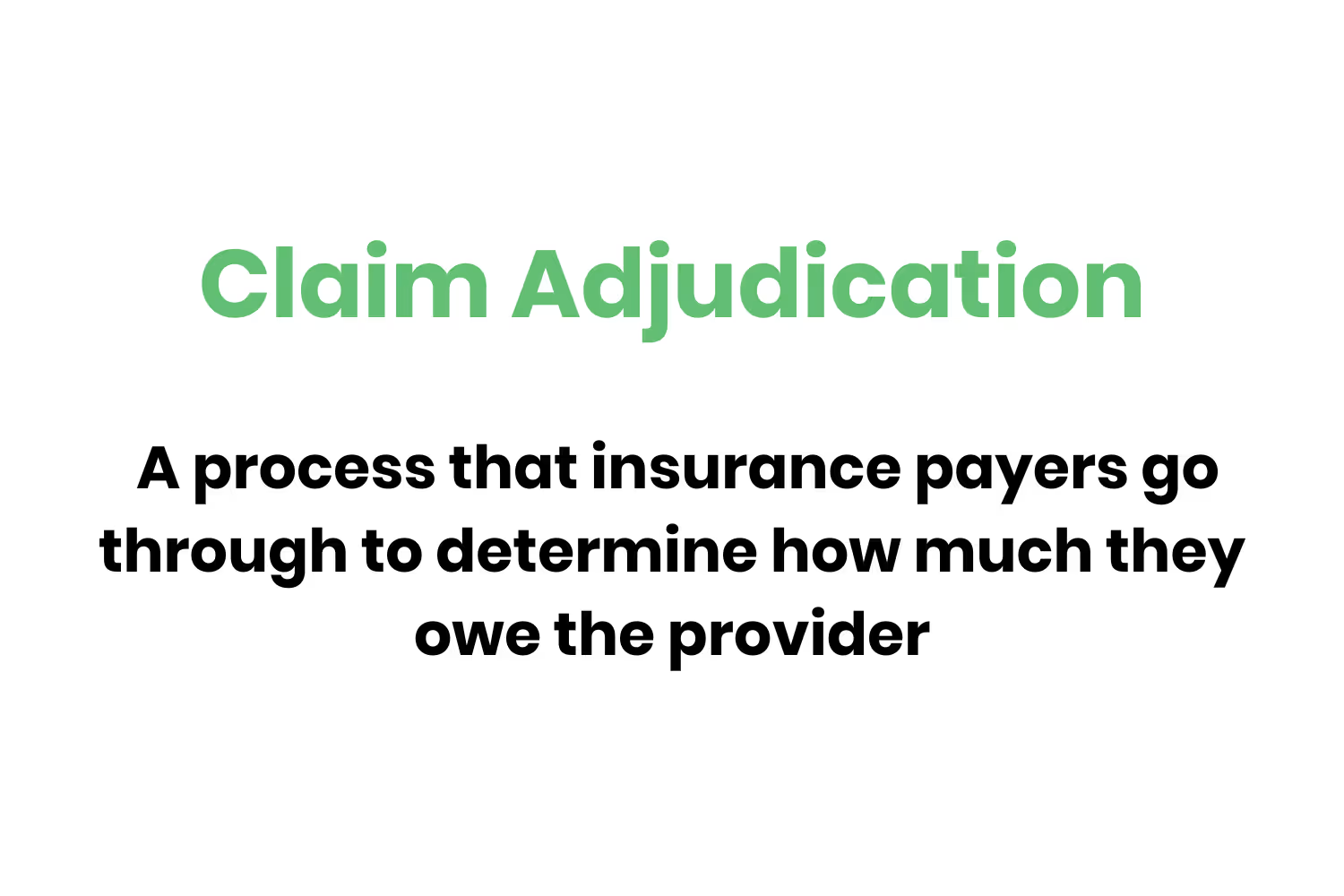
For every claim submitted to a health insurance company, the payer needs to make one of three decisions:
- Pay the full amount listed on the claim
- Pay only part of the amount listed on the claim
- Deny the claim
The ideal scenario for a healthcare provider is for the payer to pay the total amount. If you have access to the healthcare organization’s bank account, then you would see a credit appear for the total amount listed in the claim.
Sometimes, the insurance company will only pay a portion of what they owe to the healthcare organization compared to the amount listed on the claim. This happens when the payer finds that the billed service isn’t appropriate according to the diagnosis or procedure code in the claim.
Obviously, this isn’t the ideal situation. Healthcare companies want full compensation. At least there’s some form of reimbursement instead of nothing at all.
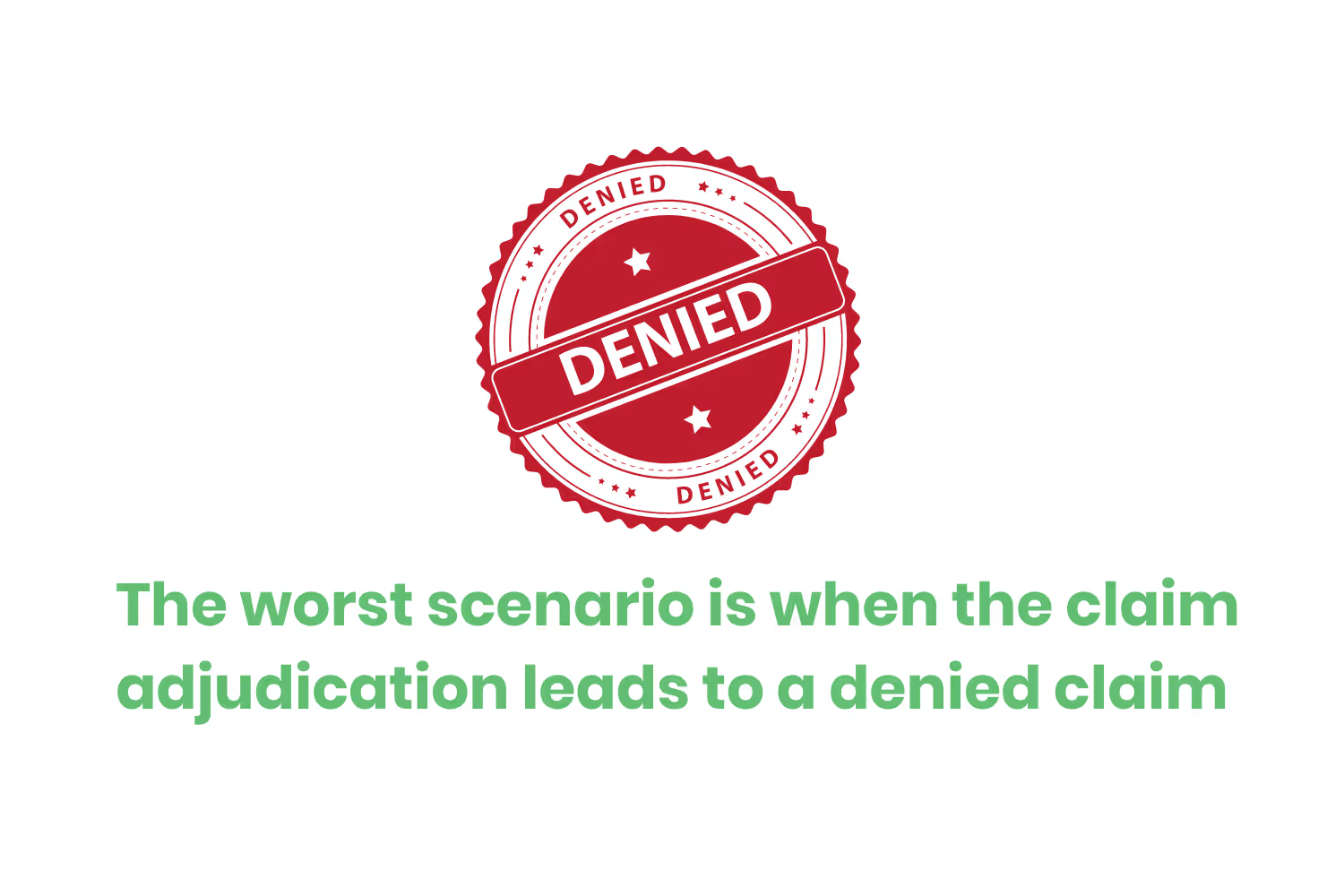
That said, the worst scenario is when the claim adjudication leads to a denied claim. Claim denials happen when there is a blatant error in the document. Normally your clearinghouse’s scrubbing process fixes these mistakes. However, not all organizations thoroughly look through claims to find errors.
When a denial happens, the payer sends back the claim to the healthcare organization. They also submit a claim rejection code and explanation. Insurance companies don’t provide compensation for denied claims until the healthcare company fixes the claim, fills out an appeal form and resubmits it.
Improving the claim adjudication process
In 2019, payers denied 18% of claims because of the exclusion of services. They denied the rest because of…
- Missing prior authorizations
- Submission errors
- Missed deadlines
- Other process issues

Denied claims lead to huge financial consequences and losses. Thus, providers must submit “clean” claims every time that don’t have any errors.
Every detail of the claim must be correct, including…
- Patient information
- Diagnosis codes
- File formats
- Timing of submissions
There are some things you can do or implement to help the healthcare provider’s administrative burden and navigate the claims adjudication process.
Utilizing Automation
In 2021, the Council for Affordable Quality Healthcare (CAQH) reported that automation could yield massive costs and time savings for healthcare providers.
Electronic claim submissions could save the healthcare industry $1.8 billion annually compared to manual processing. This is because you don’t have shipping, handling, and other human-related delays with electronic claim submissions.
In essence, if you save time and minimize human error, then you will reduce costs and gain more from successful claim adjudication.
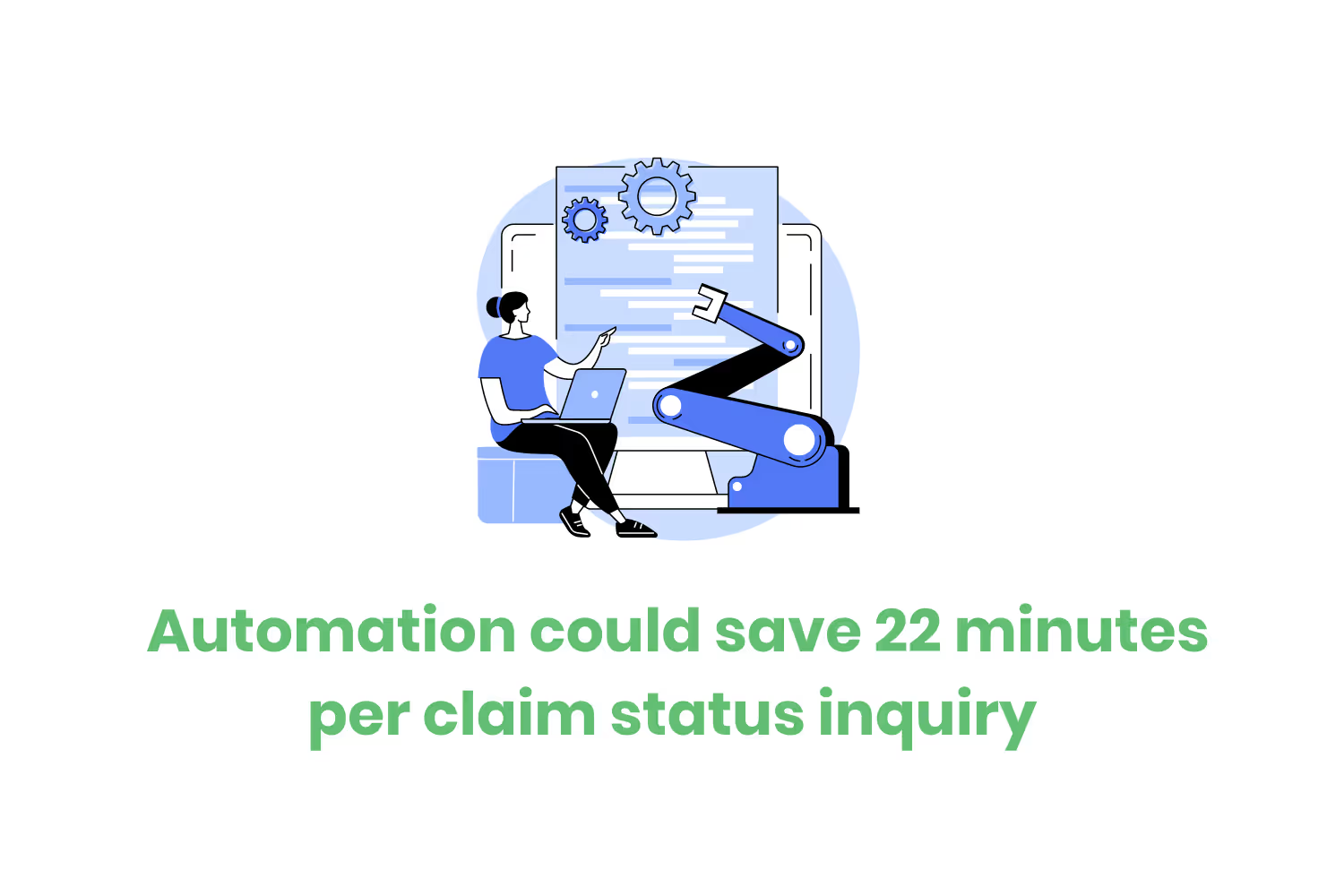
In the meantime, automation could save 22 minutes per claim status inquiry.
Automation is even better than electronic claims because it streamlines the adjudication process for both healthcare practices and insurance companies.
Insurance companies can…
- Reduce paperwork
- Accelerate adjudication
- Optimize decision-making
With automation tools and software-led workflows, providers can…
- Prevent data errors
- Prevent data duplication
- Verify patient identities
- Track payer policy changes
- Assign tasks to the right specialist
When organizations process thousands of claims each month amidst growing staffing pressures, automation is key to improving your revenue cycle.
Front-End Edits and Coding Checks
During the claim adjudication process, insurance companies comb through claims to make sure everything is as it should be. If there’s something incorrect with the claim, it will fail the payer’s initial automated review.

In turn, this can lead to denials or getting pushed to the side for manual reviews. As I mentioned before, time is costly in the healthcare world, so manual reviews will cause delays and increase costs.
These problems can have a significant impact on the healthcare entity’s revenue cycle. To avoid disruption in the organization’s finances, providers need to keep themselves up-to-date with current coding requirements and universal, local, and payer-specific edits relevant to the claim.
The best way to avoid these issues is to either use software programs to run automated checks or use a clearinghouse to run the checks for you. Both these solutions can find errors that might prevent reimbursement. For example, a clearinghouse can identify a missing prior authorization section or incorrect coordination of benefits codes.
By the way, we offer an automated clearinghouse experience.
Standardization of Claim Adjudication
Unfortunately, each insurance company has its own rules for claim submission. This means that providers must spend hours reformatting, recoding, and re-checking claims and relevant data to make sure the adjudication goes well.
Automation creates advantages for both providers and payers, as mentioned above. With so many benefits, it makes sense to pay for solutions that will save your budget and your business in the long run.
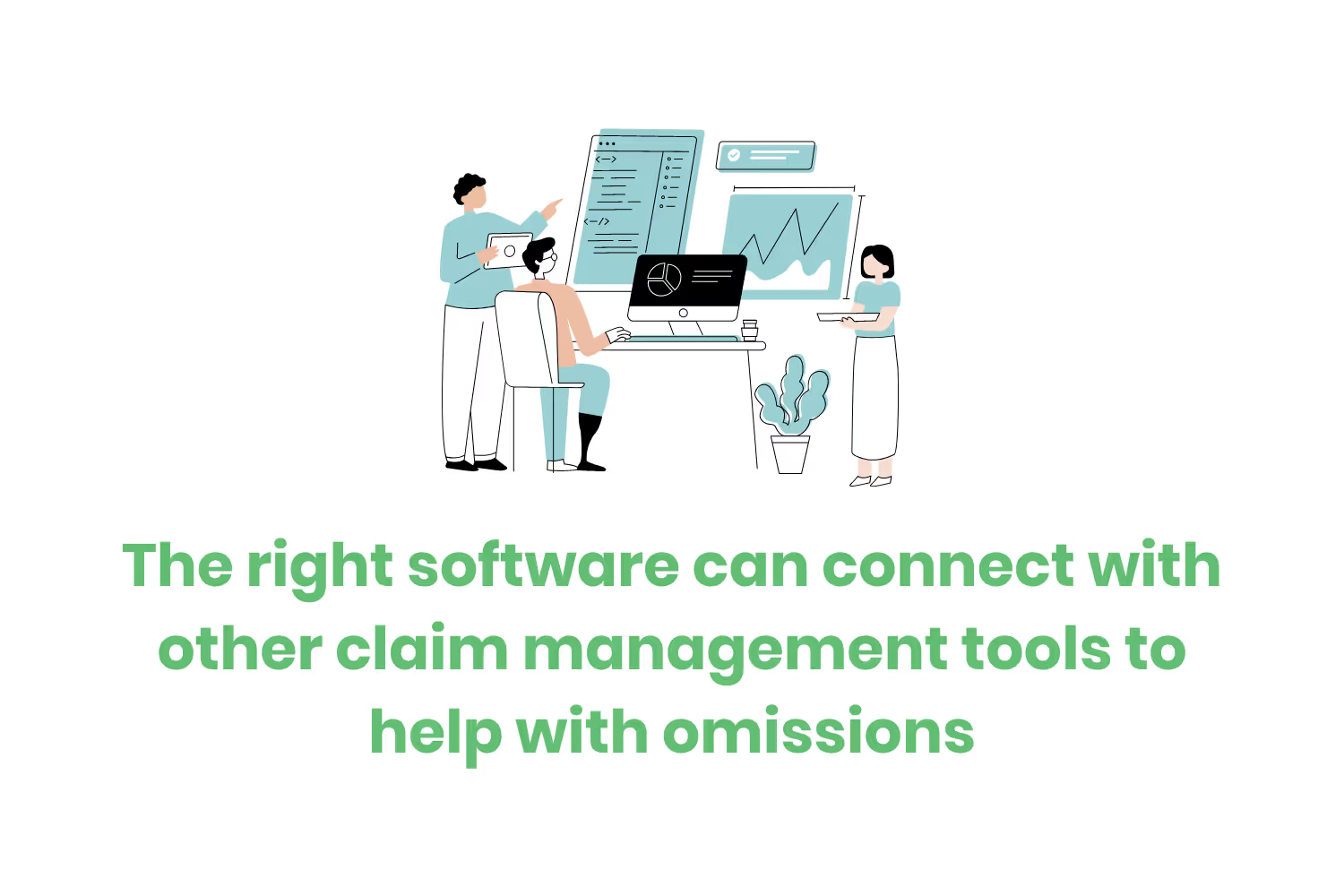
The software can pull policy updates directly from payer websites, helping providers get their claims approved and reimbursed. The right software can also connect with other claim management tools, like the ones I mentioned above, to help with authorization-related omissions.
Selecting The Right Clearinghouse
From the perspective of the healthcare provider, a clearinghouse can make all the difference between successful adjudication and denied claims. Choosing the right clearinghouse is key.
The purpose of a clearinghouse is to take the burden off of healthcare providers. They do this through the utilization of pre-emptive checks on all claims before submission. In this way, you can increase the likelihood of claim reimbursement.
Here’s how.
Payer Connections
Clearinghouses have all the software and solutions that any healthcare organization could need.
As mentioned above, each insurance company has its own EDI enrollment and adjudication requirements. This can cause quite a headache since the majority of patients use different insurance payers.
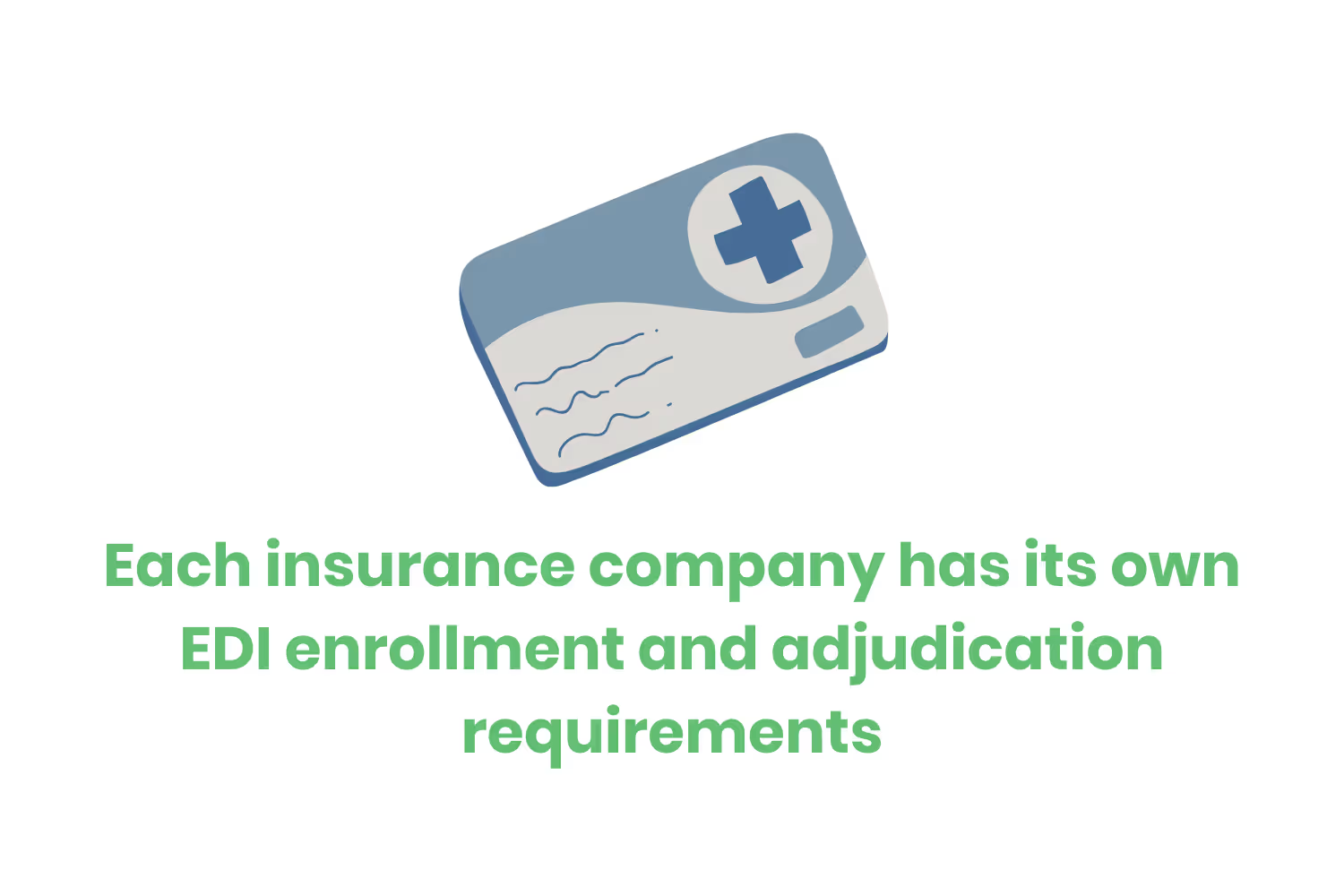
Etactics already established connections with health insurance companies. We can take those tedious tasks off of your plate.
Claim Scrubbing
Since Etactics is already familiar with the adjudication process requirements, part of our value to healthcare providers is claim scrubbing. After all, we already have those connections.
Claim scrubbing is the process of submitting a claim to a clearinghouse BEFORE submitting it to the payer. The clearinghouse will compare the claim to the payer’s requirements and give back feedback for any improvements.
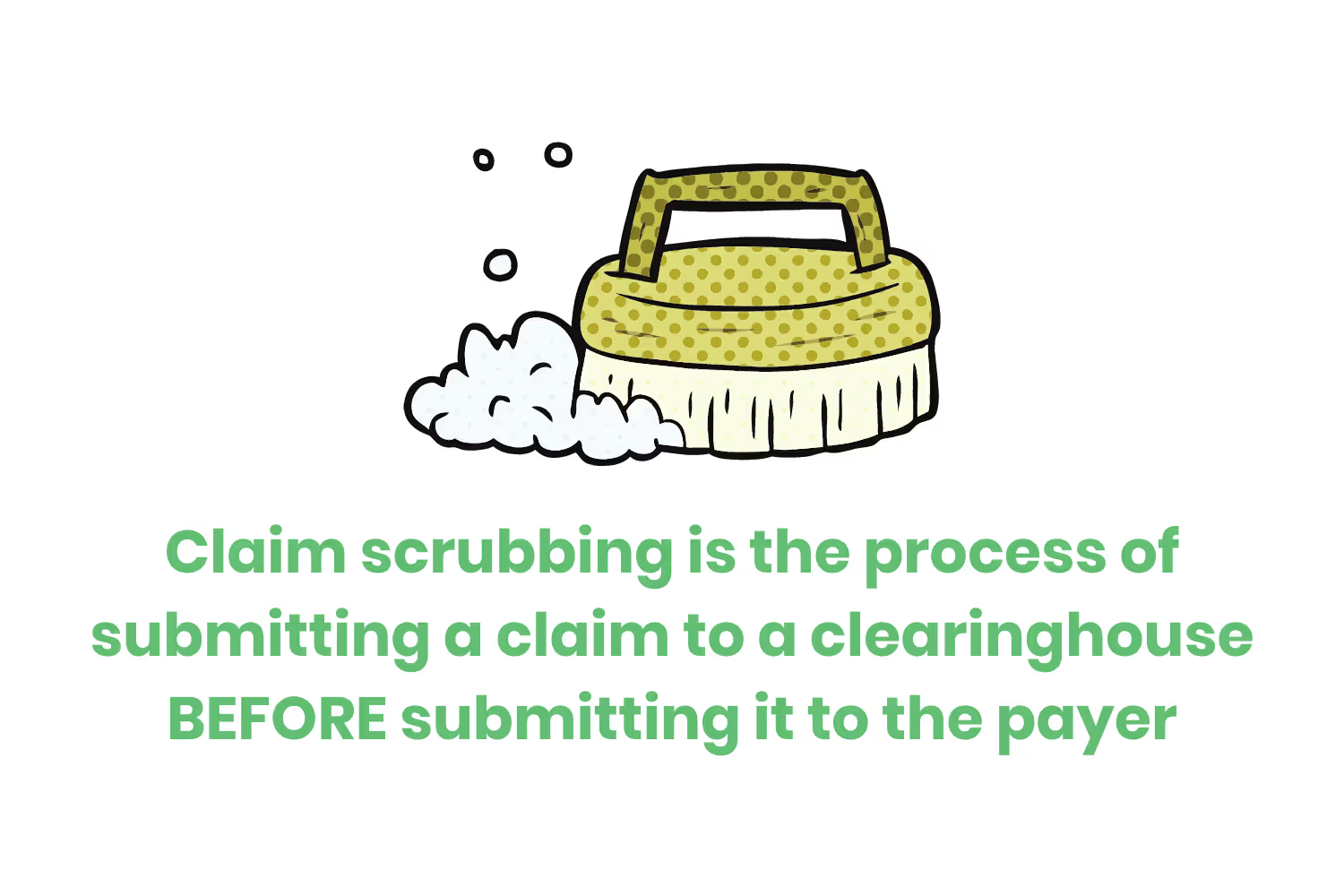
Think of claim scrubbing as insurance spellcheck. Etactics will point out any errors before sending the claim to the payer. This way, you don’t have to deal with another denial.
Predicting Claim Status
If you’ve read this far into the blog, then it's pretty obvious that a lot goes into claim adjudication. Many steps and checks are outside the control of the healthcare provider.
The only “control” you have over submitting claims for reimbursement is making sure it is 100% accurate before sendoff.
Luckily for you, Etactics provides you with the ability to gain insight into the status of your claim submission.

Knowledge of the status can make it easier for you and your employer to predict its revenue sooner. If a healthcare entity realizes that a claim is doing poorly, it can preemptively kick off an appeals process.
Think of it like ordering food for delivery, realizing there is an error in the order, fixing the error, and then getting paid.
Conclusion
What is claims adjudication? Adjudication is simply an industry term in the medical world. It's the process where a payer decides whether or not to reimburse a medical claim.
Naturally, claims adjudication isn’t that simple. Nothing is as easy as it sounds when it comes to insurance companies.
Claim reimbursement is one of the most frustrating and tedious revenue cycle processes, especially since most of it isn’t in the healthcare entity’s control.
Partnering with a clearinghouse like Etactics makes adjudication easier to manage with less stress. We streamline front-end processes and provide insights into each claim’s status. With Etactics, you can get more regular reimbursements with fewer denials.
Emphasize your product's unique features or benefits to differentiate it from competitors
In nec dictum adipiscing pharetra enim etiam scelerisque dolor purus ipsum egestas cursus vulputate arcu egestas ut eu sed mollis consectetur mattis pharetra curabitur et maecenas in mattis fames consectetur ipsum quis risus mauris aliquam ornare nisl purus at ipsum nulla accumsan consectetur vestibulum suspendisse aliquam condimentum scelerisque lacinia pellentesque vestibulum condimentum turpis ligula pharetra dictum sapien facilisis sapien at sagittis et cursus congue.
- Pharetra curabitur et maecenas in mattis fames consectetur ipsum quis risus.
- Justo urna nisi auctor consequat consectetur dolor lectus blandit.
- Eget egestas volutpat lacinia vestibulum vitae mattis hendrerit.
- Ornare elit odio tellus orci bibendum dictum id sem congue enim amet diam.
Incorporate statistics or specific numbers to highlight the effectiveness or popularity of your offering
Convallis pellentesque ullamcorper sapien sed tristique fermentum proin amet quam tincidunt feugiat vitae neque quisque odio ut pellentesque ac mauris eget lectus. Pretium arcu turpis lacus sapien sit at eu sapien duis magna nunc nibh nam non ut nibh ultrices ultrices elementum egestas enim nisl sed cursus pellentesque sit dignissim enim euismod sit et convallis sed pelis viverra quam at nisl sit pharetra enim nisl nec vestibulum posuere in volutpat sed blandit neque risus.

Use time-sensitive language to encourage immediate action, such as "Limited Time Offer
Feugiat vitae neque quisque odio ut pellentesque ac mauris eget lectus. Pretium arcu turpis lacus sapien sit at eu sapien duis magna nunc nibh nam non ut nibh ultrices ultrices elementum egestas enim nisl sed cursus pellentesque sit dignissim enim euismod sit et convallis sed pelis viverra quam at nisl sit pharetra enim nisl nec vestibulum posuere in volutpat sed blandit neque risus.
- Pharetra curabitur et maecenas in mattis fames consectetur ipsum quis risus.
- Justo urna nisi auctor consequat consectetur dolor lectus blandit.
- Eget egestas volutpat lacinia vestibulum vitae mattis hendrerit.
- Ornare elit odio tellus orci bibendum dictum id sem congue enim amet diam.
Address customer pain points directly by showing how your product solves their problems
Feugiat vitae neque quisque odio ut pellentesque ac mauris eget lectus. Pretium arcu turpis lacus sapien sit at eu sapien duis magna nunc nibh nam non ut nibh ultrices ultrices elementum egestas enim nisl sed cursus pellentesque sit dignissim enim euismod sit et convallis sed pelis viverra quam at nisl sit pharetra enim nisl nec vestibulum posuere in volutpat sed blandit neque risus.
Vel etiam vel amet aenean eget in habitasse nunc duis tellus sem turpis risus aliquam ac volutpat tellus eu faucibus ullamcorper.
Tailor titles to your ideal customer segment using phrases like "Designed for Busy Professionals
Sed pretium id nibh id sit felis vitae volutpat volutpat adipiscing at sodales neque lectus mi phasellus commodo at elit suspendisse ornare faucibus lectus purus viverra in nec aliquet commodo et sed sed nisi tempor mi pellentesque arcu viverra pretium duis enim vulputate dignissim etiam ultrices vitae neque urna proin nibh diam turpis augue lacus.



![[ANSWERED] What is a Long-Term Care (LTC) Pharmacy](https://cdn.prod.website-files.com/67e2b8210878abcba6f91ae6/68d687806a075a1cf64659b0_WhatisLongTermCarePharmacy_925.avif)
